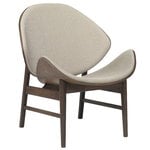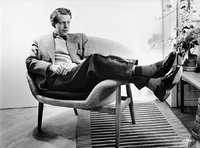The Orange lounge chair, designed by Hans Olsen in 1955, is a Danish design classic that has been re-released by Warm Nordic. The elegant and joyful chair got its name after its rounded shapes and the seat that resembles a slice of an orange. Also known as the Model 134, the Orange is a fine example of Hans Olsen’s love for playful shapes and top-quality materials. The chair has been upholstered in a durable fabric by Kvadrat, and its legs are smoked oak. The Orange adds a delightful touch of experimental design attitude of the 1950s also to contemporary interiors.
The Orange lounge chair, smoked oak - grey
Warm Nordic
Description
The Orange lounge chair, designed by Hans Olsen in 1955, is a Danish design classic that has been re-released by Warm Nordic. The elegant and joyful chair got its name after its rounded shapes and the seat that resembles a slice of an orange. Also known as the Model 134, the Orange is a fine example of Hans Olsen’s love for playful shapes and top-quality materials. The chair has been upholstered in a durable fabric by Kvadrat, and its legs are smoked oak. The Orange adds a delightful touch of experimental design attitude of the 1950s also to contemporary interiors.
Product details (9)
- Colour
- Smoked oak, grey
- Width
- 64 cm
- Depth
- 71 cm
- Height
- 77 cm
- Frame material
- Smoked solid oak base, veneer seat and back
- Upholstery fabric
- Kvadrat: Vidar 222, 94% wool, 6% nylon
- Abrasion resistance
- 100,000 Martindale
- Pilling
- 4
- Lightfastness
- 5-6
- Product ID
Designer
Hans Olsen (1919-1992) was a Danish furniture designer who is famous for his experiments with bent, laminated wood. Olsen was a student of the noted designer Kaare Klint at the Royal Danish Academy, and he developed a distinctive style by combining classic references and organic lines with a touch of humour. The Balloon lounge chair, released in 1955, is a fine example of his work.
View all productsReviews (0)
Sustainability
The Product Sustainability Framework, our criteria of sustainable design, helps you find the most sustainable products in our selection. Read below which sustainability criteria this product has met.
Working conditions & labour 9/9
-
Equal opportunities for all employees
-
Commitment to UN Global Compact, fair compensation for all employees
-
Corporate responsibility requirements defined and communicated for suppliers
-
Systematic work for improved inclusion and well-being in the workplace
-
Transparent supply chain
-
Suppliers' compliance to a code of conduct ensured
-
Direct suppliers audited and certified
-
Compliance to the UN Guiding Principles on Business and Human Rights ensured in the supply chain
-
Support for community involvement in the supply chain
Eco-friendly production 7/9
-
Fair and resource-wise water-use in production
-
No incineration or landfilling of returned items
-
No use of endangered species as materials
-
No direct environmental emissions or waste (excl. GHGs) from production
-
Material-efficient and ecological packaging
-
Positive impact on nature’s well-being through operations that regenerate natural ecosystems
-
No potentially harmful chemicals used in own production
Climate impact 4/8
-
Company's direct greenhouse gas emissions identified and commitment to reduction
-
Product's carbon impact identified and commitment to reduction
-
Guidance on energy- and eco-efficient use of the product
-
Contribution to climate initiatives beyond the brand’s direct operations
Sustainable materials 4/6
-
Sustainable and long-lasting material choices
-
No harmful or hazardous substances
-
Responsible raw material sourcing and production
-
Materials suited for circularity: monomaterials, recyclable finishings, renewable or recycled contents etc.
Circular design 4/5
-
High aesthetic quality promoting long-term use of the product
-
Technically durable product design and material choices
-
Design for enduring life-long quality
-
Design and support for product maintenance, repair and upgradability







